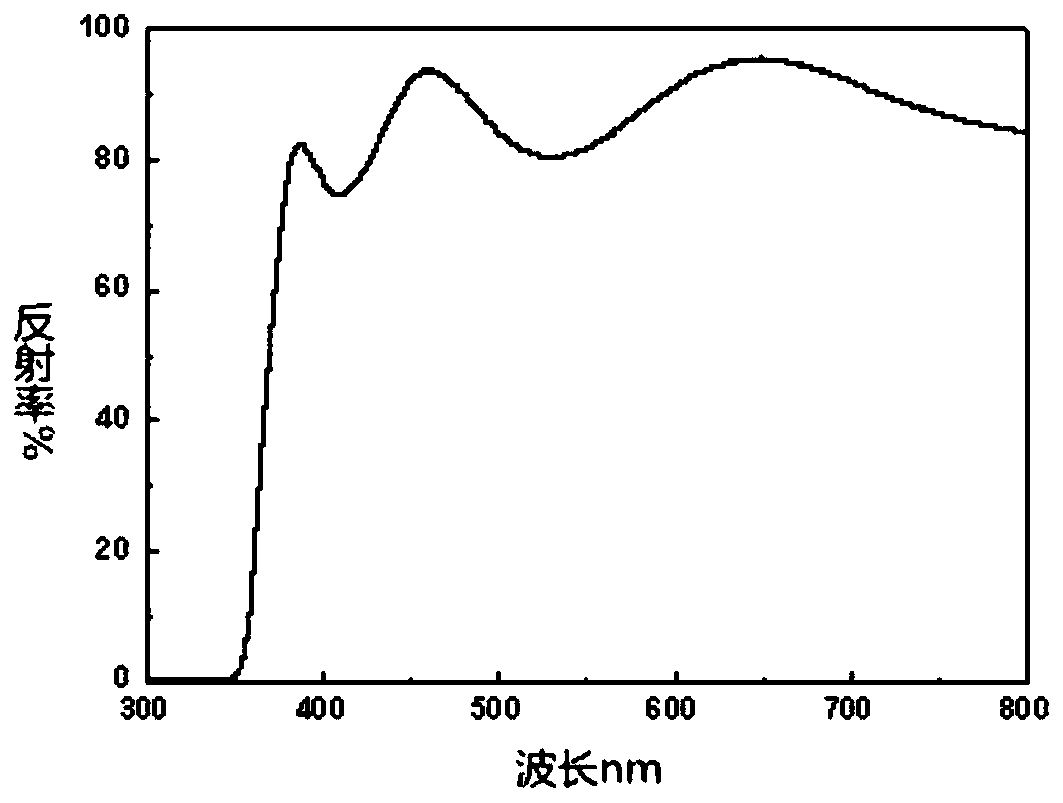Gradient layer calcium carbonate-calcium silicate total-reflection film and preparation method thereof
A calcium carbonate and calcium silicate technology, applied in coating, metal material coating process, gaseous chemical plating and other directions, can solve the problems of high cost and low life of calcium fluoride materials, and achieve low price and easy availability of raw materials. , good reflection effect
- Summary
- Abstract
- Description
- Claims
- Application Information
AI Technical Summary
Problems solved by technology
Method used
Image
Examples
Embodiment 1
[0032] The selected substrate is ITO glass purchased by CSG, ultrasonically cleaned with toluene, acetone and ethanol for 5 minutes, then rinsed with distilled water, air-dried with nitrogen, and sent to the reaction chamber of the equipment.
[0033] Use a mechanical pump and a molecular pump to evacuate the vacuum of the reaction chamber of the equipment to 4.0×10 -3 Pa; then heat-treat the substrate at 700°C for 15 minutes, and then lower the temperature to 500°C for thin film deposition.
[0034] Turn on the rotation motor and adjust the rotation speed of the substrate holder to 300 rpm.
[0035] A gas source containing calcium cyclopentadiene and argon as a carrier gas are fed in at a flow rate of 10 sccm, and then oxygen gas is fed in at a flow rate of 120 sccm to form a calcium oxide layer on the ITO glass for 18 minutes.
[0036] Introduce carbon dioxide with a flow rate of 150 sccm to deposit a calcium carbonate layer on the surface of the calcium oxide layer for 15 ...
Embodiment 2
[0040] The substrate is ITO glass purchased by CSG, and it is ultrasonically cleaned with toluene, acetone and ethanol for 8 minutes, then rinsed with distilled water, air-dried with nitrogen, and sent to the reaction chamber of the equipment.
[0041] Use a mechanical pump and a molecular pump to evacuate the vacuum of the reaction chamber of the equipment to 3.5×10 -4 Pa; then the substrate is heat-treated at 800°C for 20 minutes, and then the temperature is lowered to 500°C for thin film deposition.
[0042] Turn on the rotation motor and adjust the rotation speed of the substrate holder to 400 rpm.
[0043] A gas source containing calcium cyclopentadiene and argon as a carrier gas are fed in at a flow rate of 20 sccm, and then oxygen gas is fed in at a flow rate of 180 sccm to deposit a calcium oxide layer on one side of the ITO glass for 10 minutes.
[0044] Introduce carbon dioxide with a flow rate of 110 sccm to deposit a calcium carbonate layer on the surface of the c...
Embodiment 3
[0049] The substrate is ITO glass purchased by CSG, and it is ultrasonically cleaned with toluene, acetone and ethanol for 5 minutes, then rinsed with distilled water, air-dried with nitrogen, and sent to the reaction chamber of the equipment.
[0050] Use a mechanical pump and a molecular pump to evacuate the vacuum of the reaction chamber of the equipment to 4.0×10 -3 Pa, and then the substrate was heat-treated at 700°C for 15 minutes, and then the temperature was lowered to 500°C for thin film deposition.
[0051] Turn on the rotation motor and adjust the rotation speed of the substrate holder to 300 rpm.
[0052] Introduce the gas source containing cyclopentadiene calcium and the carrier gas Ar gas, the gas flow is 10sccm, then oxygen is introduced, the flow is 120sccm, and carbon dioxide is introduced at the same time, the flow is 150sccm, and a calcium carbonate layer is deposited on one side of the ITO glass , for 15 minutes.
[0053] Turn off the carbon dioxide, feed...
PUM
| Property | Measurement | Unit |
|---|---|---|
| thickness | aaaaa | aaaaa |
Abstract
Description
Claims
Application Information
 Login to View More
Login to View More - R&D
- Intellectual Property
- Life Sciences
- Materials
- Tech Scout
- Unparalleled Data Quality
- Higher Quality Content
- 60% Fewer Hallucinations
Browse by: Latest US Patents, China's latest patents, Technical Efficacy Thesaurus, Application Domain, Technology Topic, Popular Technical Reports.
© 2025 PatSnap. All rights reserved.Legal|Privacy policy|Modern Slavery Act Transparency Statement|Sitemap|About US| Contact US: help@patsnap.com


